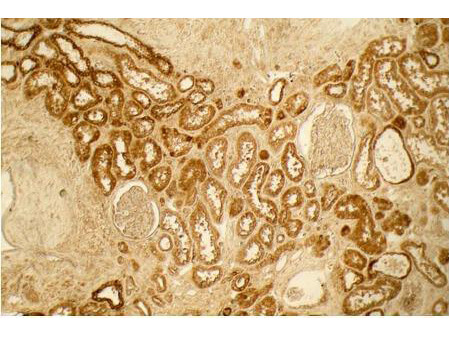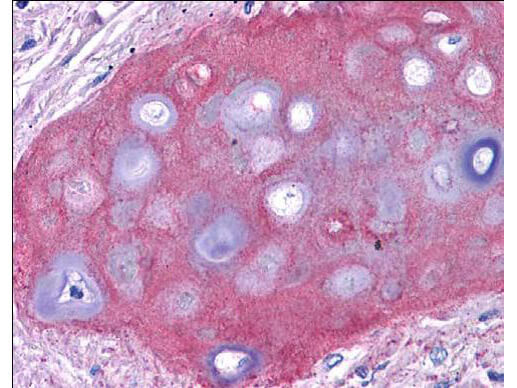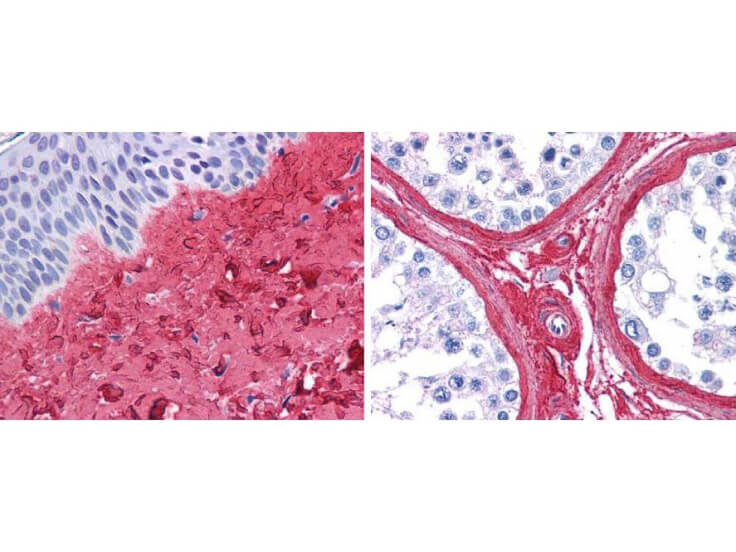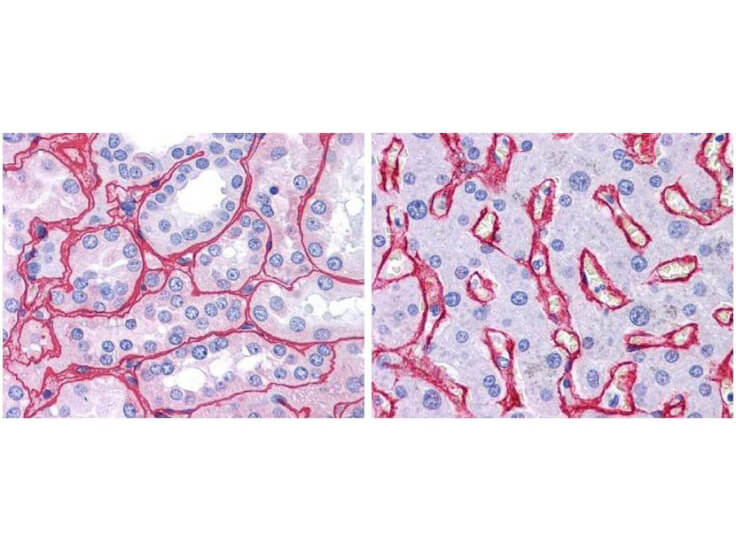The intercellular matrix (ICM), also known as extracellular matrix (ECM), represents a complex and dynamic network that envelops and provides structural support to cells in multicellular organisms. Composed of a diverse array of proteins, often referred to as the matrisome, the ICM plays a pivotal role in maintaining tissue integrity and regulating cellular behavior.

Figure. Structure of the Intercellular Matrix
Collagen, the most abundant ICM protein, forms fibrils that confer tensile strength to tissues. Elastin provides elasticity, enabling tissues to stretch and recoil. Fibronectin and laminin function as adhesive molecules, facilitating cell attachment and migration. Proteoglycans, such as hyaluronic acid, contribute to the gel-like properties of the ICM, while also aiding in cell signaling and hydration. Additionally, enzymes called matrix metalloproteinases (MMPs) regulate ICM remodeling by degrading and modifying its components. Through intricate interactions with cells, the ICM influences various biological processes including cell proliferation, migration, and differentiation. Understanding the complex interplay between cells and the ICM is crucial for unraveling fundamental mechanisms underlying tissue development, homeostasis, and disease progression.
Collagens: The Core ICM Component
Collagen, making up to 30% of the total protein mass in multicellular animals, is the predominant fibrous protein found in the ICM. Discover trusted collagen antibodies and proteins for precise detection and analysis, backed by citations in over 300 research publications.
Collagen Antibodies




Other Core ICM Components
Over 300 different proteins comprise the core matrisome (See Hynes & Naba 2012 and Naba et al. 2012 for comprehensive reviews). The following antibodies enable the accurate detection, quantification, and visualization of core ICM components in tissue samples and cultured cells.
| Product | Clonality | Reactivity | Applications |
| CRIM1 Antibody | Polyclonal | Human | WB, ELISA, IF |
| CRIM2 Antibody | Polyclonal | Human, Mouse, Rat | WB, ELISA |
| CTHRC1 Antibody | Polyclonal | Human, Mouse, Rat | WB, ELISA |
| Fibronectin Antibody | Polyclonal | Human | WB, IHC, IF |
| Fibrinogen Antibody | Polyclonal | Human | WB, IHC |
| Fibrinogen Antibody | Polyclonal | Human | WB, IHC |
| Fibrinogen Antibody | Monoclonal | Human | IHC, IF |
| Fibulin 3 Antibody | Polyclonal | Human, Mouse, Rat | WB, ELISA, IHC, IF |
| FREM1 Antibody | Polyclonal | Human, Mouse | WB, ELISA, IHC, IF |
| FREM2 Antibody | Polyclonal | Human, Mouse | WB, ELISA, IHC, IF |
| Glypican 1 Antibody | Polyclonal | Human, Mouse, Rat | WB, ELISA, IHC |
| Laminin Antibody | Polyclonal | Human | WB, ELISA, IHC, Other |
| LGI1 Antibody | Polyclonal | Human, Mouse, Rat | WB, ELISA |
| LGI1 Antibody | Polyclonal | Human, Mouse, Rat | WB, ELISA, IHC, IF |
| Lgi1 Antibody | Monoclonal | Human, Mouse, Rat | WB, IHC |
| LGI2 Antibody | Polyclonal | Human, Mouse | WB, ELISA, IHC, IF |
| LGI2 Antibody | Polyclonal | Human, Mouse, Rat | WB, ELISA |
| LGI3 Antibody | Polyclonal | Human, Mouse, Rat | WB, ELISA |
| LGI4 Antibody | Polyclonal | Human, Mouse, Rat | WB, ELISA |
| LGI4 Antibody | Polyclonal | Human, Mouse, Rat | WB, ELISA |
| MAGP-2 Antibody | Polyclonal | Human, Chimpanzee | WB, ELISA |
| MATN1 Antibody | Polyclonal | Human, Mouse, Rat | WB, ELISA, IHC, IF |
| MATN1 Antibody | Polyclonal | Human, Mouse, Rat | WB, ELISA |
| MATN2 Antibody | Polyclonal | Human, Mouse, Rat | WB, ELISA |
| MATN3 Antibody | Polyclonal | Human, Mouse, Rat | WB, ELISA, IHC, IF |
| MATN3 Antibody | Polyclonal | Human, Mouse, Rat | WB, ELISA, IHC |
| MATN4 Antibody | Polyclonal | Human, Mouse, Rat | WB, ELISA, IHC, IF |
| Osteopontin Antibody | Polyclonal | Human | WB, ELISA, IHC, Other |
| RSPO1 Antibody | Polyclonal | Human, Mouse, Rat | WB, ELISA, IHC, IF |
| Slit1 Antibody | Polyclonal | Mouse, Rat | WB, ELISA |
| SLIT2 Antibody | Polyclonal | Human, Chicken | WB, ELISA, IHC |
| SLIT3 Antibody | Polyclonal | Human, Mouse, Rat, Bovine, Dog | WB, ELISA |
| SPP1 Antibody | Polyclonal | Human, Mouse, Rat | WB, ELISA, IHC, IF |
| SRPX1 Antibody | Polyclonal | Human, Mouse, Rat | WB, ELISA, IHC, IF |
| SRPX2 Antibody | Polyclonal | Human, Mouse, Rat | WB, ELISA, IHC, IF |
| Tenascin Antibody | Monoclonal | Human | WB, IHC |
| TGF beta 1 Antibody | Polyclonal | Human | WB, ELISA, IHC |
ICM Remodellers
The ICM undergoes continuous remodeling as its components are deposited, degraded, or modified. The following antibodies target proteins involved in ICM remodelling.
| Product | Clonality | Reactivity | Applications |
| ADAM10 Antibody | Polyclonal | Human | WB, ELISA, IF |
| ADAMTSL5 Antibody | Polyclonal | Human, Mouse, Rat | WB, ELISA, IHC, IF |
| Lysyl Oxidase Antibody | Polyclonal | Human, Mouse | WB, IHC, IF, IP |
| MMP2 Antibody | Polyclonal | Human | WB, ELISA, IHC, IF |
| MMP9 Antibody | Polyclonal | Human, Mouse, Rat | WB, ELISA, IHC, IF, Cellular Assay |
| MMP16 Antibody | Polyclonal | Human, Mouse, Rat | WB, IHC |
| Plasminogen Antibody | Polyclonal | Human | WB, ELISA |
| Plasminogen Antibody | Polyclonal | Human | WB |
| TACE Antibody | Polyclonal | Human, Rat | WB, ELISA, IHC, IF |
| TIMP1 Antibody | Polyclona | Human | WB, IHC |
| TIMP4 Antibody | Monoclonal | Human | WB, ELISA |
Purified Collagenase Proteins
Collagenase, purified from Clostridium histolyticum, serves as a potent enzymatic tool, facilitating the controlled degradation of collagen-based intercellular matrices.
| Product | Origin | Size |
| Collagenase/Elastase | Porcine pancreatic elastase, Clostridium histolyticum | 1 each |
| Collagenase Type 1 | Clostridium histolyticum | 50 mg |
| Collagenase Type 1 | Clostridium histolyticum | 100 mg |
| Collagenase Type 2 | Clostridium histolyticum | 50 mg |
| Collagenase Type 2 | Clostridium histolyticum | 100 mg |
| Collagenase Type 3 | Clostridium histolyticum | 50 mg |
| Collagenase Type 3 | Clostridium histolyticum | 100 mg |
| Collagenase Type 4 | Clostridium histolyticum | 50 mg |
| Collagenase Type 4 | Clostridium histolyticum | 100 mg |
References
- Dzobo, K., Motaung, K. S. C. M., & Adesida, A. (2019). Recent Trends in Decellularized Extracellular Matrix Bioinks for 3D Printing: An Updated Review. International journal of molecular sciences, 20(18), 4628.
- Hynes, R. O., & Naba, A. (2012). Overview of the matrisome--an inventory of extracellular matrix constituents and functions. Cold Spring Harbor perspectives in biology, 4(1), a004903.
- Naba, A., Clauser, K. R., Hoersch, S., Liu, H., Carr, S. A., & Hynes, R. O. (2012). The matrisome: in silico definition and in vivo characterization by proteomics of normal and tumor extracellular matrices. Molecular & cellular proteomics : MCP, 11(4), M111.014647.